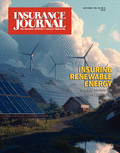The Texas Windstorm Insurance Association actuarial and underwriting committee on Monday voted to recommend no rate change for 2026 residential and commercial policies.
The TWIA board of directors will consider the recommendation when they meet on August 5. TWIA must make a rate filing on or before August 15 with the Texas Department of Insurance.
TWIA, a residual insurer of last resort, provides windstorm and hail damage coverage for more than 275,00 coastal properties.
The actuarial and underwriting committee voted 5-2 on the no rate change recommendation after reviewing an actuarial analysis that shows a substantial improvement in TWIA’s rate inadequacy. TWIA rates are inadequate by 3% for residential coverage and 5% for commercial coverage, down from double-digit inadequacy indications for more than a decade.
The change in TWIA rate inadequacy is directly related to recently passed legislation that reduces the association’s expected costs for reinsurance premium and maintenance taxes, the association said.
The Texas Legislature this year passed House Bill 3689, which changes the requirement for the probable maximum loss (PML) to be determined from 1 in-100 to 1 in-50. A 1 in 100-year PML represents a more severe, less frequent storm event compared to a 1 in-50 year PML. Significantly less reinsurance spend is required for a 1 in-50 year PML.
Lawmakers also passed House Bill 2517, which exempts TWIA from premium and maintenance tax.
The legislature was motivated to change TWIA’s funding structure after TDI Commissioner Cassie Brown disapproved of a 10% rate increase in October 2024, stating that a rate increase would be unjust and unfair because of the hardships a rate increase would impose on the coast.
Texas coastal residents already face soaring property and flood insurance costs, and critics of a TWIA rate increase say it would make owning a home or operating a business unaffordable.
TWIA has typically avoided rate changes even when its rate adequacy analysis indicated more rate was needed. Over the last decade, only twice has TWIA raised rates on residential and commercial properties – in 2018 and 2022 – each time by 5%.
TWIA board vote
The TWIA board will review the actuarial and underwriting committee’s recommendation, rate adequacy analysis, and stakeholder feedback when it votes on the annual rate filing. The board currently has a vacancy, and state law prevents the board from voting on a rate increase if a vacancy has existed for at least 60 days when the vote is taken.
The 60-day component of the vacancy rule was implemented to prevent a board member from resigning shortly before a rate decision in order to block a potential rate increase, a TWIA spokesperson said.
If the current vacancy on the board is filled before the August 5 board meeting, the vacancy rule would not apply. If the vacancy is filled later in the year, it would be possible for the Board to consider an additional rate filing for an increase later in the year.
The board can direct additional rate filings at any time.
While state law prevents a vote on a rate increase under the 60-day vacancy rule, the board could vote to lower rates.
Was this article valuable?
Here are more articles you may enjoy.


 New Book Proposes Four-Prong Legal Strategy to Negate Nuclear Verdicts
New Book Proposes Four-Prong Legal Strategy to Negate Nuclear Verdicts  Louisiana Insurers Must Disclose Prior Policy Premiums Under Controversial New Law
Louisiana Insurers Must Disclose Prior Policy Premiums Under Controversial New Law  Smith Brothers Has Acquired Charter Oak Agency in Connecticut
Smith Brothers Has Acquired Charter Oak Agency in Connecticut  Northeast Cities Ranked Riskiest in National Allstate Driving Report
Northeast Cities Ranked Riskiest in National Allstate Driving Report 

